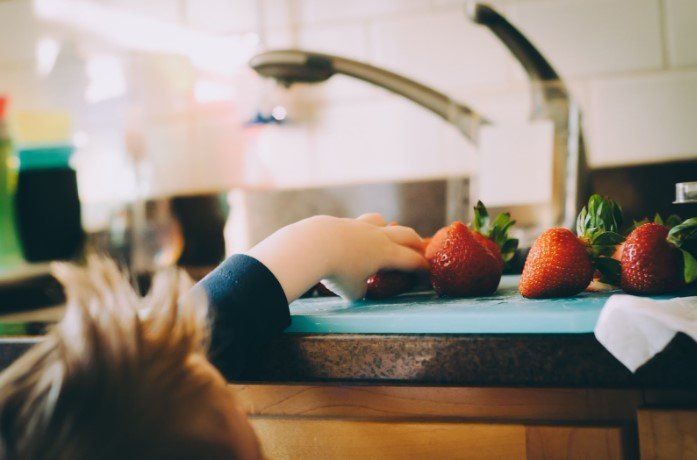
As a parent, ensuring the safety of your children is a top priority. The kitchen, with its numerous potential hazards, requires special attention when it comes to childproofing. From hot surfaces to sharp objects, it’s crucial to take proactive measures to create a safe environment for your little ones. In this article, we will explore essential safety tips for childproofing your luxury kitchen, ensuring your household is safe from any accidents.
11 Kitchen Safety Tips for Parents
- Clear the Clutter: Before we delve into specific safety measures, let’s start by addressing the clutter in your kitchen. A clutter-free kitchen is a safer kitchen, especially when it comes to childproofing. Remove unnecessary items from countertops, such as small appliances, sharp utensils, and breakable dishes. This will reduce the risk of accidents and ensure that your little ones have fewer items to reach for.
- Store Hazardous Items Securely: The first step in childproofing your kitchen is to store hazardous items securely. This includes cleaning supplies, sharp utensils, medications, and potentially toxic substances. Keep them out of reach and preferably in locked cabinets or drawers. Consider using childproof locks to add an extra layer of protection.
- Install Safety Latches on Cabinets and Drawers: Children are naturally curious and can quickly explore every nook and cranny. Installing safety latches on cabinets and drawers will prevent them from gaining access to potentially dangerous items. There are various types of safety latches available, including magnetic locks and spring-loaded latches. Choose the ones that best suit your needs and ensure they are properly installed.
- Secure Large Appliances: Large appliances such as refrigerators, dishwashers, and ovens can pose risks to children if not properly secured. Use appliance straps or brackets to anchor them to the wall or floor, preventing them from tipping over. This is especially important for ovens, as children may be tempted to climb on open oven doors, leading to severe injuries.
- Install Safety Gates: Installing safety gates at the entrance of the kitchen can help create a barrier between your child and potential hazards. Choose gates that are sturdy, with a secure latch mechanism. Make sure the gate is properly installed and cannot be easily pushed over or climbed over by your little one.
- Secure Window Areas: Windows near the kitchen can also be a source of danger for children. Install window guards or window stops to prevent children from falling out or getting their fingers caught in the window frames. Keep window cords and blinds out of reach, as they can pose a strangulation risk.
- Safe Kitchen Countertops: Choose Heat-Resistant Materials: When selecting countertops for your kitchen, opt for heat-resistant materials such as granite or quartz. These materials can withstand high temperatures without getting damaged or posing a burn risk to your child. Avoid materials like laminate, which can easily scorch or warp when exposed to hot pots and pans.
- Keep Hot Items Out of Reach: While heat-resistant countertops provide a level of protection, it’s still important to keep hot items out of reach of children. Place hot pots, pans, and other cookware on the back burners of the stove whenever possible. Use the stove’s rear elements before the front ones to minimize the risk of accidental burns.
- Use Corner Guards: Countertop edges can be sharp and pose a risk of injury if a child were to accidentally bump into them. Install corner guards on the edges of your countertops to create a cushioned barrier. These guards are typically made of soft materials like rubber or foam and can significantly reduce the severity of injuries in case of a collision.
- Regularly Inspect Gas Lines: Gas leaks can have severe consequences, so it’s essential to regularly inspect your gas lines for any signs of damage or leaks. Look for cracks, loose fittings, or hissing sounds near the gas pipes. If you detect a gas odor or suspect a leak, evacuate your home immediately and contact a professional to address the issue.
- Install a Gas Shut-Off Valve: Consider installing a gas shut-off valve near your kitchen for added safety. This valve allows you to turn off the gas supply to the kitchen in case of an emergency or when it’s not in use for an extended period. Make sure all family members know the location of the shut-off valve and how to operate it.
- Keep Flammable Materials Away: Store flammable materials such as cleaning solvents and aerosol cans away from the gas stove or oven. These materials can ignite if they come into contact with an open flame or get too close to a hot surface. Keep them in a separate cabinet or storage area, preferably in a well-ventilated space.
In Conclusion
Childproofing your kitchen is crucial to ensure the safety of your little ones. By implementing these essential safety tips, including securing hazardous items, installing safety latches, and using safety gates, you can significantly reduce the risk of accidents in the kitchen. Remember, a well-childproofed kitchen allows you to enjoy cooking and spending time with your family without unnecessary worries.








